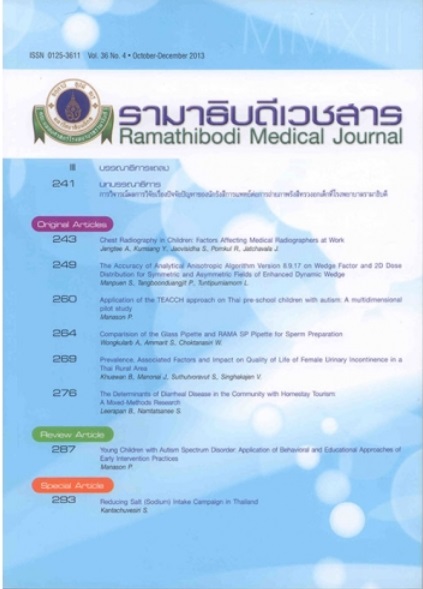Chest Radiography in Children: Factors Affecting Medical Radiographers at Work
Main Article Content
Abstract
Objective: To improve quality of work in performing chest radiography in children, we aimed to study factors/problems affecting medical radiographers during their work.
Methods: A total of 46 radiographers answered the evaluation sheets which include their demographic data; the children’s age range that caused problems; factors or problems related to patients (children), parents, overall service, the radiographer themselves, along with other problems observed during their work. The factors/problems were scored as 1 to 5 (least serious to most serious). All data were analyzed in the term of frequency, percentage, mean value, including standard deviation using the software STATA 11.0.
Results: Majority of radiographers (73.9%) were female. Working experience less than 5 years = 60.9%, 6 - 10 = 6.5%, and more than 10 years = 32.6%. The child’s age range that caused maximal problem was > 2 - 4 years, followed by newborn to 2 years. Factors related to the patients (children) that caused maximal problem was the child’s movement (score 4.78 from 5), followed by the child under gone other procedure (distress) before coming to Radiology Department (score 4.28). Factors related to the parents were the parents’ anxiety (3.60), followed by fear of radiation hazard (3.50). Factors related to the service in overall were delayed service to the next patient (3.50), followed by repeated radiography to reach the standard (3.36). Regarding factors related to the radiographers themselves, the most frequent problem was the radiographers’ feeling that taking chest radiography of a child was a difficult task (2.76), follow by their assistant did not help them to fix the children (2.69).
Conclusions: While performing chest radiography in children; the problems occurred most seriously with children aged 2 - 4 years. The factors/problems that most serious are the child’s movement and the parent’s anxiety, which resulted in delayed service to the next patients. The radiographers themselves also had a feeling that taking chest radiograph of a child was a difficult task.
Article Details
References
The National Research Council of Thailand. Positioning and Immobilization Device for Infant Chest Radiography. Available at https://i4biz.nrct.go.th/NRCT_PLATINUM58/home/show_product.php?research_id=1759.
Hanpanich P, Kheonkaew B, Kumkantee S, et al. Chest X-ray equipment giraffe’s model. Srinagarind Med J. 2011;26(3):163-167.
Fuller MJ. Notes on Pediatric chest radiography. Available at: https://www.wikiradiography.com.
Joseph Jr N. Film Critique – Part 1: Chest. Online Radiography Continuing Education for Radiologi X ray Technologist. Available at https://www.gotoknow.org.
https://www.gotoknow.org/posts/403985.
Hanpanich P, Kheonkaew B, Kumkantee S, et al. Panda’ model for children of the chest X-ray equipment. Srinagarind Med J. 2013;28(1):2-8.
Frush DP, Donnelly LF, Chotas HG. Contemporary pediatric thoracic imaging. AJR Am J Roentgenol. 2000;175(3):841-851.
Chest X-ray for children. Children’s Hospital of Pittsburgh. Available at https://www.chp.edu/CHP/chest+xrays.
